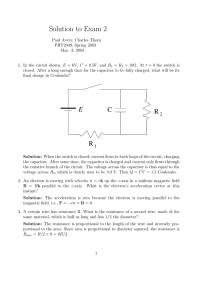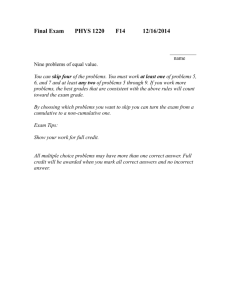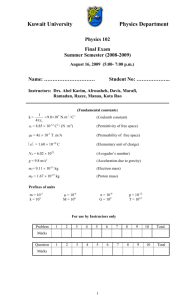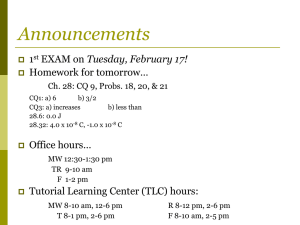Displacement Currents & Maxwell's Equations Worksheet
advertisement
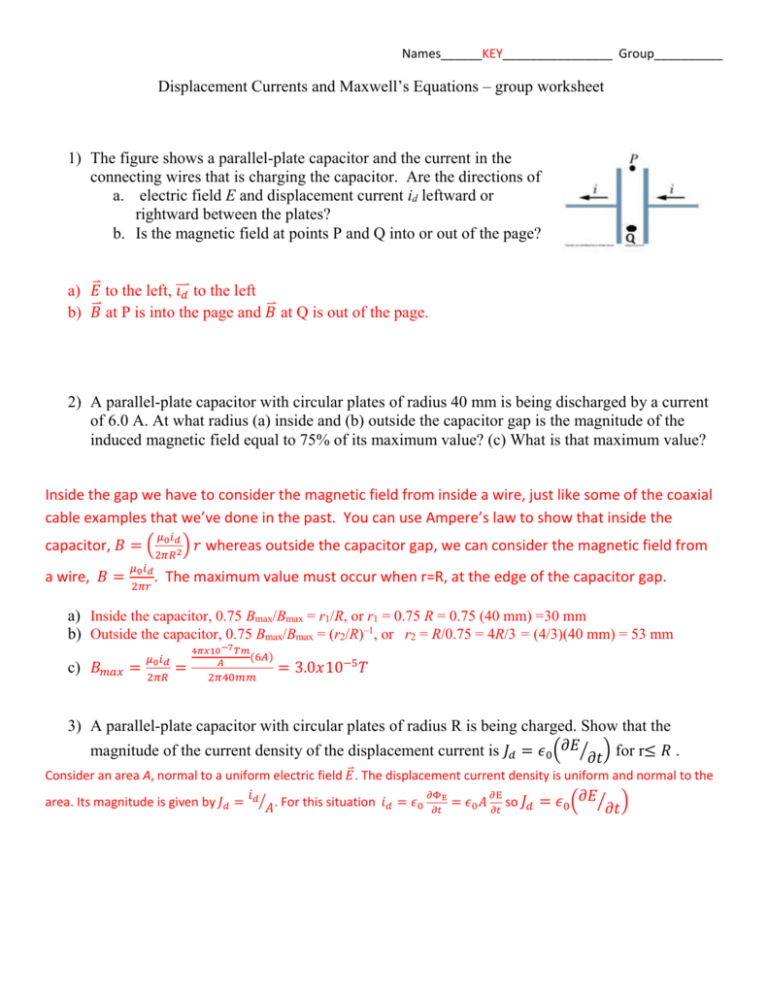
Names______KEY________________ Group__________ Displacement Currents and Maxwell’s Equations – group worksheet 1) The figure shows a parallel-plate capacitor and the current in the connecting wires that is charging the capacitor. Are the directions of a. electric field E and displacement current id leftward or rightward between the plates? b. Is the magnetic field at points P and Q into or out of the page? a) 𝐸⃑ to the left, ⃑⃑⃑ 𝑖𝑑 to the left ⃑ at P is into the page and 𝐵 ⃑ at Q is out of the page. b) 𝐵 2) A parallel-plate capacitor with circular plates of radius 40 mm is being discharged by a current of 6.0 A. At what radius (a) inside and (b) outside the capacitor gap is the magnitude of the induced magnetic field equal to 75% of its maximum value? (c) What is that maximum value? Inside the gap we have to consider the magnetic field from inside a wire, just like some of the coaxial cable examples that we’ve done in the past. You can use Ampere’s law to show that inside the capacitor, 𝐵 = ( a wire, 𝐵 = 𝜇0 𝑖𝑑 2𝜋𝑟 𝜇0 𝑖𝑑 2𝜋𝑅2 ) 𝑟 whereas outside the capacitor gap, we can consider the magnetic field from . The maximum value must occur when r=R, at the edge of the capacitor gap. a) Inside the capacitor, 0.75 Bmax/Bmax = r1/R, or r1 = 0.75 R = 0.75 (40 mm) =30 mm b) Outside the capacitor, 0.75 Bmax/Bmax = (r2/R)–1, or r2 = R/0.75 = 4R/3 = (4/3)(40 mm) = 53 mm c) 𝐵𝑚𝑎𝑥 = 𝜇0 𝑖𝑑 2𝜋𝑅 = 4𝜋𝑥10−7 𝑇𝑚 (6𝐴) 𝐴 2𝜋40𝑚𝑚 = 3.0𝑥10−5 𝑇 3) A parallel-plate capacitor with circular plates of radius R is being charged. Show that the magnitude of the current density of the displacement current is 𝐽𝑑 = 𝜖0 (𝜕𝐸⁄𝜕𝑡 ) for r≤ 𝑅 . Consider an area A, normal to a uniform electric field 𝐸⃑ . The displacement current density is uniform and normal to the 𝜕Φ 𝜕E 𝑖 area. Its magnitude is given by 𝐽𝑑 = 𝑑⁄𝐴. For this situation 𝑖𝑑 = 𝜖0 E = 𝜖0 𝐴 so 𝐽𝑑 = 𝜖0 (𝜕𝐸⁄ ) 𝜕𝑡 𝜕𝑡 𝜕𝑡 4) A silver wire has resistivity ρ=16.2(nΩ∙m) and a cross‐sectional area of 5.00mm2. The current in the wire is uniform and changing at the rate of 2000 A/s when the current is 100 A. (a) What is the magnitude of the (uniform) electric field in the wire when the current in the wire is 100 A? (b) What is the displacement current in the wire at that time? (c) What is the ratio of the magnitude of the magnetic field due to the displacement current to that due to the current at a distance r from the wire? 𝑖 a) 𝐸 = 𝜌𝐽 = 𝜌 𝐴 = 1.62𝑥10−8 Ω𝑚 (100𝐴) 5𝑥10−6 𝑚2 = 0.324 𝑉/𝑚 𝜕Φ 𝜕𝐸 𝜕 𝜌𝑖 𝜕𝑖 b) The displacement current is 𝑖𝑑 = 𝜖0 𝜕𝑡𝐸 = 𝜖0 𝐴 𝜕𝑡 = 𝜖0 𝐴 𝜕𝑡 ( 𝐴 ) = 𝜖0 𝜌 𝜕𝑡 = (8.85𝑥10−12 𝐹⁄𝑚)(1.62𝑥10−8 Ω𝑚)(2000 𝐴⁄𝑠) = 2.87𝑥10−16 𝐴 𝐵(𝑑𝑢𝑒 𝑡𝑜 𝑖𝑑 ) 𝜇 𝑖 ⁄2𝜋𝑟 𝑖 2.87𝑥10−16 𝐴 c) The ratio of the fields is 𝐵(𝑑𝑢𝑒 𝑡𝑜 𝑖) = 𝜇0 𝑖𝑑⁄2𝜋𝑟 = 𝑖𝑑 = = 2.87𝑥10−18 100𝐴 0
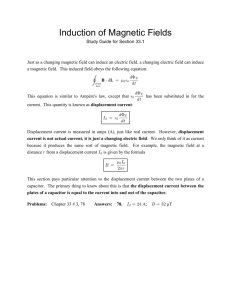
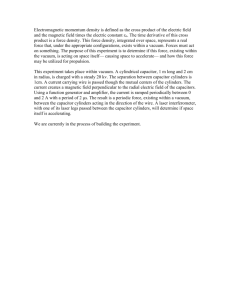
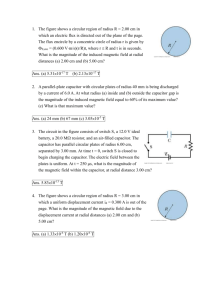
![Sample_hold[1]](http://s2.studylib.net/store/data/005360237_1-66a09447be9ffd6ace4f3f67c2fef5c7-300x300.png)


